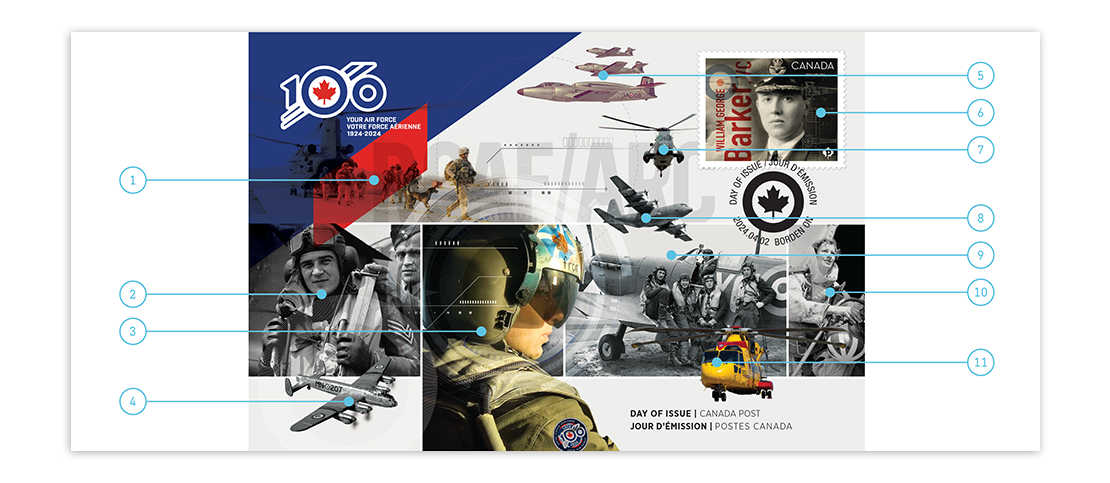While thousands of Canadians served in the British flying services during the First World War, it wasn’t until after the war that military aviation became a permanent part of Canada’s defence organization. In 1920, a temporary Canadian Air Force was authorized by an Order-in-Council, and members served on a part-time basis.
After receiving the “Royal” designation from King George V, it became a permanent component of Canada’s defence force, one hundred years ago on April 1, 1924. The Royal Canadian Air Force (RCAF) became a distinct branch of the Canadian military and went on to play a key role in the Allied victory in the Second World War. Since that time, the RCAF has been called up to contribute to major Canadian deployments in Europe, Africa, the Middle East, and Asia.
Drawing on images of Canada’s military aviation past
The front of the commemorative envelope features a collage of official Department of National Defence photographs, which depict the past and current work of the RCAF.

- November Company, 3 RCR Battle Group disembarks a CH-147D Chinook at Kandahar Airfield after completing an air mobile operation, in December 2008. This image commemorates the first time a Canadian Chinook carried troops into combat operations in a theatre of war.
- Sergeant Pilot Omer Lévesque is helped into his parachute, July 1941. Lévesque was the first Commonwealth pilot to shoot down a German Focke-Wulf Fw-190.
- Captain Jason McGillis aboard an RCAF CH-148 Cyclone helicopter during Operation Reassurance, in October 2018.
- RCAF Lancaster. After the Second World War, the RCAF employed the Lancaster in a variety of roles including maritime patrol, Arctic patrol and aerial surveying.
- Air-to-air view of three CF-100 Canuck aircraft in formation. The CF-100 was the first jet fighter designed and built in Canada.
- William George Barker, VC, was the first acting director of the RCAF. This stamp was part of the Canadians in Flight series, issued March 27, 2019.
- A CH-124 Sea King helicopter, August 2014. The Sea King was capable of conducting maritime surface patrols, search and rescue and transport, among other tasks.
- An RCAF CC-130H Hercules aircraft, equipped with air-to-air refueling pods, is captured in flight, July 2017. Image courtesy of Derek Heyes.
- A group of Canadian fighter pilots in the 401 Canadian Fighter Squadron pose with a Spitfire, February 1942. Left to right: Flight Sergeant J. Whitham, Edmonton, Alberta; Flight Sergeant H. McDonald, Toronto, Ontario; Pilot Officer H.J.L. Merritt, Smithville, Ontario; at the controls, Pilot Officer G.F. Newton, Vancouver, British Columbia; and Sgt. C.S. De Nacrede, Calgary, Alberta.
- Flying Officer Marian Neily, an RCAF para-rescue nursing sister, March 1955. Flying Officer Neily was the first of the “Para-Belles” to jump and also the last to serve.
- CH-149 Cormorant helicopter at Summerside Airport, Slemon Park in Prince Edward Island during a boat camp exercise, June 2015.
Protecting the present, safeguarding the future
Today the RCAF is tasked with defending and protecting Canadian and North American airspace and contributes to international peace and security through its commitments to organizations such as the North American Aerospace Defense Command (NORAD) and the North Atlantic Treaty Organization (NATO). The RCAF also serves at home, providing such capabilities as search and rescue and assistance to communities affected by natural disasters.
The commemorative envelope is cancelled in Borden, Ontario. Canadian Forces Base Borden (also CFB Borden), formerly RCAF Station Borden, is the historic birthplace of the Royal Canadian Air Force, and home to the largest training wing in the Canadian Armed Forces. The base is run by Canadian Forces Support Training Group (CFSTG) and reports to the Canadian Defence Academy (CDA) in Kingston, Ontario.
The cancel mark takes its inspiration from the RCAF roundel – officially a blue ring surrounded by a white area with a red maple leaf in the centre – which identifies aircraft belonging to the RCAF, Royal Canadian Navy (RCN) Fleet Air Arm and Canadian Army.
Commemorative envelope salutes Royal Canadian Air Force's 100th anniversary
Available now